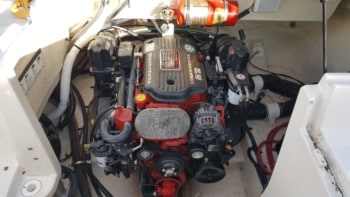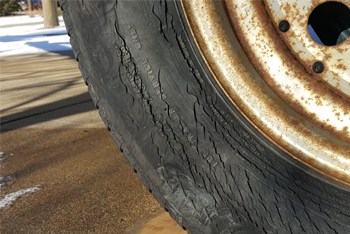Buying a used boat from a private seller may make a newbie boat buyer nervous. Since they don’t know what to look for, newbie buyers often pay premium prices at dealers.
Here’s a list of areas to focus on when buying used boats. We will break down each area of the boat so you know what to look for to be certain you are buying a well maintained boat.
- Hull
- Engine
- Outdrive
- Floor
- Interior
- Electronics
- Trailer
When buying from a private seller, your odds of getting a better deal goes way up . We’ll discuss this more in this article, as well as show you how to inspect a boat.
What You Need To Know About A Used Boat
You should start out with a simple conversation with the private seller of the boat. It’s more of an interview, but you want to keep it light in hopes of getting more honest answers. Here are some questions to ask the owner:
 How long have you owned the boat? (You want to know how long they owned it, so when they’re answering other questions about the boat, we know over what period of time they have experience with this particular boat.)
How long have you owned the boat? (You want to know how long they owned it, so when they’re answering other questions about the boat, we know over what period of time they have experience with this particular boat.)- When was the last time they used the boat, and about how many time a year on average, do they use it? (It’s better for a boat to get regular use and maintenance. Long periods of time of it just sitting can end up being bad for seals, fuel, oil, cables, etc.)
- When was the last oil change and how often are they done? (Then look at the oil and see if it looks more used than he said.)
- Do the same with the gear oil in the outdrive.
- Ask the owner what fuel he runs in the boat and when was the last time they added fuel to the tank. (A boat fuel system really should be kept fresh)
- What repairs were done to the boat while they owned it? (Look at the parts and see if they look replaced or repaired.)
- Where do they store the boat during the cold months? (Is it stored indoors or just using a cover. Condensation happens when stored outdoors along with a repeated freeze and thaw.)
You may or may not get completely honest answers from a private seller, but don’t think that you’ll always get them from a dealer either. In fact the dealer isn’t the one that has long term experience using this boat, or even knows the history on it. A boat dealer makes money by buying low and selling high. I would much rather just buy low myself.
Target Areas Of A Boat Inspection
Hull:
What you’ll want to know when looking at the Hull of the boat, is it structurally sound and water tight. You’ll need to look at every surface to inspect for any cracking which would indicate excessive flexing. You’ll also be looking for chips and gouges, as they are most likely letting water into the boat.
You should also look for any repairs that have been made to the hull, again we’re talking about from top to bottom and front to back inspection. “Everywhere”. Just note that all of the imperfections should be repaired correctly.
Engine:
 Is the engine clean? The overall condition of the motor often depicts how well it was maintained. Is the oil clean, dark/dirty, or milky colored? Dirty can just mean it is time for an engine service (when did they say they had it changed last?). Milky colored means there is water in the oil and you should really just end your boat inspection there. Find another boat.
Is the engine clean? The overall condition of the motor often depicts how well it was maintained. Is the oil clean, dark/dirty, or milky colored? Dirty can just mean it is time for an engine service (when did they say they had it changed last?). Milky colored means there is water in the oil and you should really just end your boat inspection there. Find another boat.
If the oil is good, then check for slop or stiffness in the throttle cable. You should have smooth, instant reaction to your movements. Do the belts look good? Is there any burnt or loose wires in the engine bay?
Hook it up to a water supply and run it. Does it start easy and idle well? With the outdrive disengaged, give it a little throttle and be sure the engine reacts smoothly at 1500 RPM. Verify that all gauges are working properly at this time.
Outdrive:
Now engage the outdrive. Move the throttle just into forward gear. Does it engage smoothly with out any chatter? Do the same for the reverse gear. While in neutral move the trim down and up noticing if the trim gauge is working properly. Leave it in the full up position and shut off the engine.
Look and feel for any cracks or breaks in the any of the bellows. Then lower the trim all the way down without hitting the ground. Check the outdrive drain plug for metal chips as explained in my free boat inspection list.
Floor:
 This is a big deal. As a new boater, or just one who wants to “not” have hard work ahead of them, you want to be sure the floor is solid. Using your foot, push hard all around the boat’s floor. You are trying to feel any spots that flex down. Working on or replacing a rotted boat floor is not a fun experience and is time consuming. You can read another of my articles on what it takes to repair a rotted boat floor.
This is a big deal. As a new boater, or just one who wants to “not” have hard work ahead of them, you want to be sure the floor is solid. Using your foot, push hard all around the boat’s floor. You are trying to feel any spots that flex down. Working on or replacing a rotted boat floor is not a fun experience and is time consuming. You can read another of my articles on what it takes to repair a rotted boat floor.
There are ways to firm up your boat floor, but depending on how long you want the repair to last, it can get quite expensive and very time consuming. If you’re OK with getting a very big discount on the boat purchase, then just firming up the floor for a few good years more of service, then go for it. Again, read my article and weigh out your options.
Electronics:
Turn on the accessory switch and test out some of the other electronics in the boat.
- Navigation lights
- Radio and speakers
- Interior courtesy lights
- Bilge pump
- Engine bay blower
- Horn
- Fresh water pump (if equipped)
- Shower drain discharge pump (if equipped)
You should also look up under the dash/helm for loose wires and corrosion. Look at as much of the wiring as you can see for the same.
Interior:
This is mostly obvious. Are there any tears, rips or cracking in the interior vinyl? If so, those won’t get any better with further use. However, if you have a sewing machine, it isn’t that difficult to replace a bad panel in a seat cover.
As far as dirt and mold on the interior, don’t be too afraid of it. You just might be surprised how easy it is to clean them up with the right products! Is the carpet in good condition? Again, if it’s just dirty, you can clean that. But if the carpet isn’t sticking down in places, that could be a sign of the floor beginning to go bad. Also look in the ski hold. Is there any water standing? How about in the engine bay?
Trailer:
 Check out the condition of the tires. Boat trailer tires tend to never wear out the tread, but instead deteriorate from dry rot. Look at the sidewalls of the tire for cracking. If you see too much, then don’t tow it until you have good tires. If the cracking is minimal, you can probably take it for the water test and then home if you buy it, but you need to get new tires.
Check out the condition of the tires. Boat trailer tires tend to never wear out the tread, but instead deteriorate from dry rot. Look at the sidewalls of the tire for cracking. If you see too much, then don’t tow it until you have good tires. If the cracking is minimal, you can probably take it for the water test and then home if you buy it, but you need to get new tires.
Wiggle the tires in and out to feel for bearing play. If it’s not too excessive, you’re probably good until you get it home to service them. If it’s equipped with brakes, verify that they are functioning. Test this the way my free boat inspection list instructs you to do.
Last but not least, hook up the wiring to your vehicle and verify that all lights and signals work properly.
More Things To Know About A Used Boat
Running The Boat In The Water:
Your final step is to tow the boat to the lake and test it out. I know I’m beating this into the ground, but you really need to check out my free boat inspection list to get a step by step list of in-water inspection points.
Once you have found out everything that you need to know about this used boat, it’s time to decide if this is the boat for you. If it is, then negotiate the lowest price possible that makes both parties satisfied. (Actually, I want to be excited and happy about the deal. I want the seller to not be sad about the deal.)
Insurance:
You should know what an insurance policy for your boat will cost you. Progressive is a good place to get a quote from. In fact I have some example quotes that you should look at on my article called Are Boats A Waste Of Money: Pros and Cons – New or Used. This will help you get an idea on policy cost.


